A proposed transit line connecting Woodlawn, downtown Baltimore, Canton and Bayview, Md., has been revived by Maryland Gov. Wes Moore. The project, which was originally envisioned as a 14-mile light-rail project, was cancelled by former Maryland Gov. Larry Hogan in 2015. The revived project will evaluate various modes of transportation to determine the best fit to provide an east-west transit connection.
“This is a day that we have spent weeks planning for. This is the day that all partners in government have spent months preparing for and this is the day that many Marylanders have spent years waiting for,” Gov. Moore told a crowd gathered at a MARC station for the Red Line revival announcement.
After detailing the history of the project, Gov. Moore explained the decision to end the project was one that stretched beyond the cancellation of a transit project.
“That decision was about who would reap the benefits of transportation investments and who would be left behind,” said Gov. Moore.
Cynthia Shaw, president of the Lyndhurst Community Association and a public transportation user who worked to engage the community during the initial Red Line outreach process, spoke at the event and noted she and others worked to get the project shovel ready and fully funded before the project’s cancellation.
“We are in a space and place of gratitude,” said Shaw. “We have a request: Please put the shovel in the ground. We did the work, you have community support, please put the shovel in the ground.”
Next steps for the project
“Before it was canceled in 2015, the initial Red Line plan was shaped by more than 10 years of study, engineering, environmental analysis and substantial community participation,” said Maryland Department of Transportation Secretary Paul J. Wiedefeld. “Having signed the original Red Line Community Compact 15 years ago, I know this project and the tremendous benefits it will bring to the community are long overdue.”
To better connect the communities along the proposed corridor, the Maryland Transit Administration (MTA) will begin limited-stop bus service starting in the fall of 2023.
MTA will be evaluating light-rail and bus rapid transit options. Both options were studied as part of the Red Line Environmental Impact Statement and the East-West Feasibility Study. The extent of tunneling will be examined as well, to find options to reduce or eliminate downtown tunneling through on-street alignments. The section of the project through Highlandtown and Bayview will need to be adjusted from the previous project due to development in the Highlandtown area.
MTA will also update the environmental documentation for the revived project. MTA explains the area in the Red Line study has not changed significantly since 2013 but notes an update will assess project impacts and reflect current conditions, as well as integrate with other projects.
These evaluations will occur throughout the end of the year, and MTA estimates it will request entry into the Federal Transit Administration Capital Investment Grants program in 2024.
MTA will also launch the Eastern Baltimore County Access Study to evaluate alignments for further expansions east into Baltimore County. This future phase of the Red Line will seek to connect the current alignment to the job centers in eastern Baltimore County.
“We’re going to work together and seize this moment in our nation’s history when the stars are aligned to invest in public transit. Our communities are expanding, our jobs are growing, and we need to make sure that everyone in the region can get from where they live to where opportunity lies,” said Gov. Moore.

Mischa Wanek-Libman | Group Editorial Director
Mischa Wanek-Libman is director of communications with Transdev North America. She has more than 20 years of experience working in the transportation industry covering construction projects, engineering challenges, transit and rail operations and best practices.
Wanek-Libman has held top editorial positions at freight rail and public transportation business-to-business publications including as editor-in-chief and editorial director of Mass Transit from 2018-2024. She has been recognized for editorial excellence through her individual work, as well as for collaborative content.
She is an active member of the American Public Transportation Association's Marketing and Communications Committee and served 14 years as a Board Observer on the National Railroad Construction and Maintenance Association (NRC) Board of Directors.
She is a graduate of Drake University in Des Moines, Iowa, where she earned a Bachelor of Arts degree in Journalism and Mass Communication.




